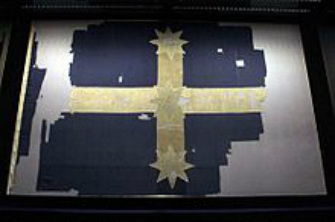IntroductionThe indomitable spirit of the Borderer is well known. Descendants from many Border families were brave, enterprising and natural born leaders in their field, whether military, agricultural, or just plain old fashioned pioneers. In this months post I shall introduce you to just one branch of a family we have met previously on more than one occasion, most notably in the tragedy of the wreck of the "Royal Charter" in October 1859 off the coast of Anglesey, on a return voyage from the gold fields of Melbourne, Australia. I am talking of course about the Hogarths. In particular the post focuses on the descendants of Agnes Stewart, maternal cousin to Robert Hogarth of potato fame, remember him? If not I will post a link at the end so you can refresh your memories. Robert's father George Hogarth died at Lennelhill in 1791 and it was George's sister Margaret through her marriage to Alexander Stewart/Stuart in 1835 who was the mother of Agnes and her descendants who are the subject of this months offering. Circa 1855 Agnes Stewart married James Thomson. Together they would be the foundation of a farming dynasty throughout Berwickshire and North Northumberland. Their daughter Margaret married Patrick Johnston tenant farmer of Simprim and their daughter Jean married Matthew Trotter of Rothill, Whittingham Vale, Northumberland. Their son James married Patricia Grieve but that is another story entirely! James Johnston son of Margaret Thomson and Patrick Johnston married his first cousin Matthew Jane Trotter daughter of Jean Thomson and Matthew Trotter of Rothill in 1821. Margaret and Jean Thomson were sisters Lt Col James Johnston KTS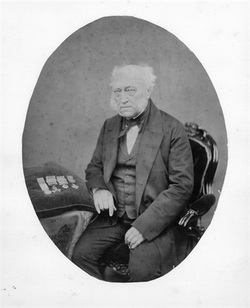 Lt Col. James Johnston KTS 1788-1861 Lt Col. James Johnston KTS 1788-1861 James Johnston was baptised at Swinton on 26th December 1788 to parents Patrick Johnston and Margaret Thomson, tenant farmers in Little Swinton and Simprim. On 21st May 1821 he married his maternal first cousin Matthew Jane Trotter at Duns Manse. He is described in his marriage announcement as "Lt Col in the Portuguese Service and Major in the British Service". In 1829 James was promoted to Lt Col in the 99th Regiment (Lanarkshire Regiment) of Foot. The couple spent the early years of their marriage overseas with at least four of their 9 children born in Mauritius where James was head of the British Military Force. They had returned to Edinburgh by 1838, and had taken up residence in Mount Lodge, Portobello, where in September of the same year James was made a "Knight of the Tower and Sword", a Portuguese military honour in recognition of his outstanding service during the Peninsular War. This was but one of the many decorations he received throughout his military career. (Hold this thought readers...) He was also Provost for Duddingston and Portobello for eleven years prior to his retirement in 1860. He did much to improve the water supply and drainage for the town but not before his wife and cousin died in April 1850, of typhus, tragically contracted from water in the well in the grounds of Mount Lodge, their youngest son was but nine years old. James outlived his wife by a further eleven years, passing away at their home on 12th November 1861. He was survived by 3 sons and one daughter. All his sons followed in their fathers military footsteps. The eldest, Patrick was by this time a Lt Col in the 99th Regiment of Foot in his own right, third son George a Lieut in the Royal Marines, but it was to be his second son James born in Mauritius in 1826 after a stint of 10 years and a Lieutenant with the 39th Dorsetshire Regiment who would play a pivotal role in the events that led to the establishment of Australian democracy on the gold fields of Victoria at Ballarat. (A touching footnote from a close descendent of Lt Col James Johnston "his Regimental Dress Sword and Scabbard have recently been re-united, the first time since 1861") Ballarat a City Built on GoldBallarat or "Balla arat" the aboriginal for "resting place" was a sparsely populated sheep station founded in 1837 by Scotsman Archibald Yuille. It wasn't until gold was discovered in 1851 ironically at a place called "Poverty Point" that the worlds attention focused on this rural area of Victoria and the "Eureka" goldfields. Mass global immigration followed and within months the area's population had grown to approximately 20,000 migrants, scattered in tented shanty towns around the area's hills and creeks. 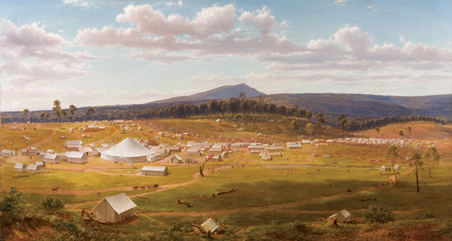 Tented City of Ballarat in 1853-1854 Tented City of Ballarat in 1853-1854 The sustained high gold yields meant a further influx of migrants seeking their fortunes and it is estimated that at its height in 1858 these numbered in the region of 60,000. Ballarat would be transformed, by 1957 botanical gardens had opened to the public and the period from the 1860's to the early 20th century saw impressive buildings and structures built on the wealth from gold mining. The massive influx of people of all nationalities required governance and regulation. To this end Gold Commissioners were appointed to issue licences, and the police commission and colonial forces to mange civil order. Given the diversity and number of people that made up the migrant population trouble was inevitable . The defining moment came on 3rd December 1854. The event became known as the "Eureka Stockade" James Johnston jnr, Assistant Gold Commissioner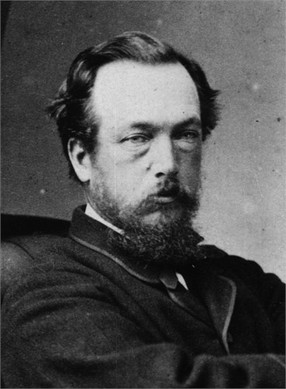 James Johnston 1826 - 1885 James Johnston 1826 - 1885 Our intrepid adventurer James Johnston junior son of the Lt Col, left Scotland in 1852, bound for the gold fields of Victoria. In November 1853 he was appointed to the post of Assistant Gold Commissioner with an annual salary of £400. His financial position seemingly secured he sent for his fiance Margaret Brown Howden to join him. Margaret was born in Duns in 1831, the daughter of Francis Howden and Sophia Brown. Francis Howden was the son of Isabella Grieve the sister of Patricia Grieve who married James Thomson (see above), so James and Margaret were in fact, related by marriage. Margaret set sail on the "Hurricane" in May 1854 arriving in Melbourne on the 2 August. She married her sweetheart just seven days later. By the beginning of September they had arrived at the English Government compound known as Camp Hill, situated on an Escarpment overlooking the tented shanty towns of Ballarat. Tension was building, the miners were objecting to the rising cost and random inspection of their licences. Then one of their number was murdered, a Scotsman by the name of James Scobie! Inquest & Trouble FlaresJames Scobie was murdered on the 7th October 1854 outside the Eureka Hotel following a late night/early morning drunken brawl. An inquest into his death was held the same afternoon. James Bentley owner of the hotel, his wife Catherine and other members of staff were chief suspects. The case was adjourned due to lack of evidence. The miners were unsatisfied with the outcome and brought pressure to bear on the authorities. A full judicial enquiry was held on the 12th October over which Gold Fields Commissioner Robert Rede, Police Magistrate John Dewes, and Assistant Gold Commissioner James Johnston presided. Police Magistrate John Dewes was well known amongst the mining community for his shady dealings with hotel proprietor James Bentley. During the period of adjournment a 10 minute conversation was observed between the pair. When the hearing reconvened and the case was dismissed by Rede and Dewes, Johnston was not happy, and neither were the miners. They had expected a unanimous verdict of guilty. 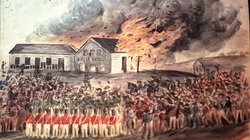 Outraged by the outcome the miners planned a further meeting to be held on the 17th October outside the "Eureka Hotel" to petition for a full criminal investigation. A riot ensued, the hotel was burned to the ground and Bentley and his crew fled for their lives. The miners got their wish and when Bentley was apprehended a full blown trial at Melbourne's Supreme Court commenced on the 18th November. On the 20th, Bentley and two others were finally found guilty of manslaughter. With no confidence in the authorities to mete out justice and the draconian measures imposed by the Gold Commissioners with regard to licence inspections the Ballarat Reform League was formed on 11th November. Their resolution based on the Chartist principles of the day stated "that it is the inalienable right of every citizen to have a voice in making the laws he is called on to obey, that taxation without representation is tyranny". Whilst the League sought to negotiate with Gold Commissioner Rede, he had other ideas. Rather than listen to the miners, Rede merely increased the police presence and brought in reinforcements from Melbourne.
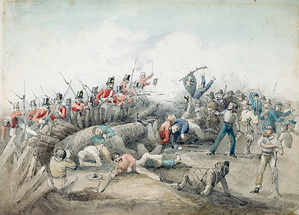 The Eureka Stockade The Eureka Stockade There was now a strong military presence in the form of the British Army from the military garrison in Victoria and at 3.00 am on the morning of Sunday the 3rd December the troops advanced on the makeshift stockade and battle commenced. Poorly armed and lacking ammunition the miners were soon overwhelmed, leaving at least 22 dead and 34 wounded. Following the fighting, 120 men were detained of which 13 were tried in February 1855 for High Treason, all were acquitted to great public acclaim. Commissioner Rede was hastily removed to an insignificant post in rural Victoria! The democratic actions by the authorities following the revolt is hailed by many as the birth of Australian democracy and as such the Southern Cross or Eureka flag attained national symbolism - a topic that is still hotly debated. The fact however remains that the battle that became known as the "Eureka Stockade" is the only armed rebellion to have occurred in Australian history. Johnston Family LifeFollowing the rebellion the Gold Commission was abolished and replaced by Mine Wardens, Licences replaced by an annual "miners right" and export tax based on the weight of gold extracted. With his position gone and his name cleared of any wrong doing James Johnston turned to farming. Their first child was born the 30th April 1855, James and his wife Margaret would go on to have a further 14. The couple returned to Edinburgh for a short period around 1861, no doubt visiting his father who was in ailing health. It was during this visit that one son David Wardlaw Brown Johnston died on the 24th April aged 18 months and another Patrick was born a month later on 30th May, at the family home of Mount Lodge. James died in Buninyong, Ballarat on the 23 January 1885 aged 59 and his wife Margaret the 13th July 1888 aged 57, they were survived by 11 of their 15 children. They were fortunate not to live to see the tragedy and travesty that was to befall their eldest son, also called James in 1891. Tragedy at BallaratThe youngest James had made the trip to visit his grandfather in 1861 and would have had vague memories of the great old military man in Edinburgh. Back in Australia and twenty one years later, James Johnston of Donors Hill, son of James Johnston Esq of Buninyong was married to Mary (Minnie) Gourlay Harvey daughter of Robert M Harvey a surveyor in Buninyong on the 12th January 1882. Together they had 4 children 3 girls and a boy. James was a livestock auctioneer of some note, having worked previously on a large cattle station in Queensland, where a fall from his horse and the resulting head injuries necessitated his return home. It was stated at the time he was lucky to have survived! 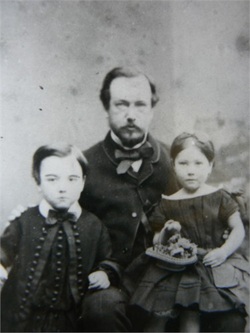 James Johnston 1856 - 1891 James Johnston 1856 - 1891 Several accounts of the events of the evening of the 9th December 1890 exist, but it is widely reported that in the late evening of the 9th, Johnston entered the room where his children slept with their nurse and quietly smothered them in their beds. The nurse was not woken until she heard a noise, later presumed to have been pistol shot, from his wife's room. Hearing a door shut and the house fall silent she returned to sleep. Waking early the next morning and trying to rouse the children the horror of what had happened became apparent. Rushing to the room of her mistress she discovered Mrs Johnston on the floor in a bloodied state, her arms covered in lacerations and having received a shot to the head. James was later discovered shivering and unconscious in a spare bedroom have allegedly tried to take his own life with poison. James and his wife were rushed to hospital, but the latter died a week later. The bullet was lodged too deep in her brain to be operable. Speculation abounded, was this a cruel premeditated murder by a man in financial difficulty saving his family from disgrace?, or the actions of a man rendered insane as a result of the head injuries he sustained many years previous? As is true to this day, once the press had hold of the story all manner of theories and reports were published, making it impossible to separate fact from fiction. One newspaper even reported that James had died in hospital without regaining consciousness! The nurse Katie Hicks, later told of Mr Johnston's mood swings that accompanied his severe headaches which at times left incapable of speech. Surely this would have been picked up by the medical examiners at his trial? Apparently not! He was tried and sentenced to death by hanging, the sentence to be carried out on the 11th May 1891. A last minute reprieve was received from Johnston's supporters to allow for a full medical examination to determine his mental condition. No evidence of insanity being found, James met his untimely death a week later on the 18th May 1891 at Ballarat Gaol. Even this caused much controversy and angst amongst the prison staff. As James was unable to walk how were they to get him to the scaffold? The warders flatly refused and even prisoners bribed with a reprieve would not play any part in assisting the executioner in his grisly task. He was eventually wheeled to the scaffold in an invalid chair. ConclusionWhatever the reasons or motives behind these murders, it remains a terrible tragedy with deadly consequences. Even today mental illness remains a largely misunderstood and 'taboo' subject. Hopefully James would have received the medical treatment that his mental condition warranted, and not as one family member is rumoured to have reported, been administered mercury for his headaches. As to the press, what can be said. The same is as true today as it was then! One statement that I find most annoying and is quoted all over the internet is that James Johnston, Assistant Gold Commissioner (father of the above) was the nephew of George Johnston who helped arrest and depose Governor (Captain) Bligh. This simply is not true, he was no relation at all. With a father of such standing there would be no need to invent a family connection such as this. I can only conclude that this notion was conceived long after his death! LinksRobert Hogarth of Carfraehttp://www.bordersancestry.co.uk/blog/a-place-a-philosopher-the-potato-a-private-printers-painters-publishing-the-pacific-a-pirate-part-ii
Accounts from a few newspapers http://trove.nla.gov.au/ndp/del/article/26767592 http://paperspast.natlib.govt.nz/cgi-bin/paperspast?a=d&d=EP18910328.2.67 http://paperspast.natlib.govt.nz/cgi-bin/paperspast?a=d&d=NZH18910528.2.51 More about Lt Col James Johnston KTS and his home Mount Lodge, Portobello http://www.kosmoid.net/portobello/mountlodge
1 Comment
31/3/2021 12:39:26 am
Good morning. I am a member of the Learmonth Historical Society. we have a small folder on James Johnston. I was enquiring about whether or not we would be able to copy this article to add to the file. All authorships, copyrights etc would be included .
Reply
Leave a Reply. |
AuthorSusie Douglas Archives
August 2022
Categories |
Copyright © 2013 Borders Ancestry
Borders Ancestry is registered with the Information Commissioner's Office No ZA226102 https://ico.org.uk. Read our Privacy Policy

